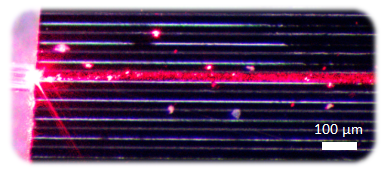Research Direction
The Microdevices Lab at Whitworth University is currently focused on researching new ways to fabricate, integrate and apply devices with functional elements at the microscale (1 to 500 μm or on the scale of a human hair thickness ~100 μm). With the advent of the semiconductor industry, a race to features less than 10nm (or ~100 atoms) in integrated electronic circuits resulted which gave us faster, better and cheaper electronic devices such as smartphones. This race, however, sped past the microscale and into the nanoscale circumventing many potential applications. Therefore, we are exploring new applications and novel technology to take advantage of microdevices.
Microfluidic Devices

Microfluidic devices, or devices with fluid channels on the micron-scale, are examples of microdevices that can involve mixers, pumps and valves. Microfluidic devices are commonly used to analyze biological systems. One example is shown above where a C. elegans microscopic worm is being analyzed in a 200μm wide microfluidic channel with a fluorescently labelled pharynx (mouth).
Photonic Devices

Photonic devices, manipulate photons or light to interact with matter to gain function or information. One example of a photonic microdevice is a waveguide, or a pipe for light, that can direct light to areas of interest (such as the above ridge waveguide 30μm wide by 5μm high with guided red light). This is a fundamental component in integrated photonic circuits that are used in, for example, telecommunications or biosensors.